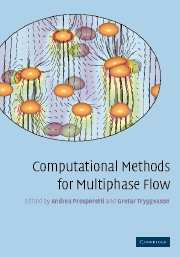Book contents
- Frontmatter
- Contents
- Preface
- Acknowledgments
- 1 Introduction: A computational approach to multiphase flow
- 2 Direct numerical simulations of finite Reynolds number flows
- 3 Immersed boundary methods for fluid interfaces
- 4 Structured grid methods for solid particles
- 5 Finite element methods for particulate flows
- 6 Lattice Boltzmann models for multiphase flows
- 7 Boundary integral methods for Stokes flows
- 8 Averaged equations for multiphase flow
- 9 Point-particle methods for disperse flows
- 10 Segregated methods for two-fluid models
- 11 Coupled methods for multifluid models
- References
- Index
4 - Structured grid methods for solid particles
Published online by Cambridge University Press: 07 December 2009
- Frontmatter
- Contents
- Preface
- Acknowledgments
- 1 Introduction: A computational approach to multiphase flow
- 2 Direct numerical simulations of finite Reynolds number flows
- 3 Immersed boundary methods for fluid interfaces
- 4 Structured grid methods for solid particles
- 5 Finite element methods for particulate flows
- 6 Lattice Boltzmann models for multiphase flows
- 7 Boundary integral methods for Stokes flows
- 8 Averaged equations for multiphase flow
- 9 Point-particle methods for disperse flows
- 10 Segregated methods for two-fluid models
- 11 Coupled methods for multifluid models
- References
- Index
Summary
In this chapter we discuss numerical methods based on structured grids for direct numerical simulations of multiphase flows involving solid particles. We will focus on numerical approaches that are designed to solve the governing equations in the fluid and the interaction between the phases at their interfaces.
In methods employing structured grids, there are two distinct possibilities for handling the geometric complexities imposed by the phase boundaries. The first approach is to precisely define the phase boundaries and use a body-fitted grid in one or both phases, as necessary. The curvilinear grid that conforms to the phase boundaries greatly simplifies the specification of interaction processes that occur across the interface. Furthermore, numerical methods on curvilinear grids are well developed and a desired level of accuracy can be maintained both within the different phases and along their interfaces. The main difficulty with this approach is grid generation; for example, for the case of flow in a pipe with several hundred suspended particles, obtaining an appropriate structured body-fitted grid around all the particles is a nontrival task. There are several structured grid generation packages that are readily available. Nevertheless, the computational cost of grid generation increases rapidly as geometric complexity increases. This can be severely restrictive, particularly in cases where the phase boundaries are in time-dependent motion. The cost of grid generation can then overwhelm the cost of computing the flow.
The alternative to a body-fitted grid that is increasingly becoming popular are Cartesian grid methods. Here, irrespective of the complex nature of the internal and external boundaries between the phases, only a regular Cartesian mesh is employed and the governing equations are solved on this simple mesh.
Information
- Type
- Chapter
- Information
- Computational Methods for Multiphase Flow , pp. 78 - 112Publisher: Cambridge University PressPrint publication year: 2007
Accessibility standard: Unknown
Why this information is here
This section outlines the accessibility features of this content - including support for screen readers, full keyboard navigation and high-contrast display options. This may not be relevant for you.Accessibility Information
- 1
- Cited by
